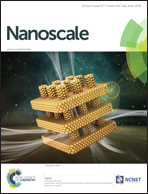Transparent multi-layer graphene/polyethylene terephthalate structures with excellent microwave absorption and electromagnetic interference shielding performance†
Abstract
A high-performance electromagnetic interference (EMI) shielding structure based on pure graphene (without doping) consists of several graphene sheets separated by transparent polyethylene terephthalate (PET) films. We report the theoretical and experimental design, and characterization of the multi-layer graphene/PET structures. With a total graphene thickness of only 4 nm, the graphene/PET sample demonstrated an average shielding effectiveness of 19.14 dB at 18–26.5 GHz, with a maximum microwave absorbance of 95.82% at 25.7 GHz, while maintaining a normalized visible transmittance of 80.5%. For the multi-layer graphene/PET samples, the contribution of absorption to the total shielding exceeds 96%, indicating that absorption is the dominant shielding mechanism, instead of reflection. The microwave absorbance of the multi-layer graphene/PET structure increases rapidly from the mono- to the four-layer structures, and then more gradually as the number of layers continues to increase when the thickness of PET is 1 mm. In addition, the microwave absorbance can be improved two-fold by increasing the separation between graphene layers. We believe that this multi-layer graphene/PET structure, which exhibits high-performance microwave absorption and shielding, has great potential for applications in transparent EMI shielding devices, especially if EMI absorption is required.


 Please wait while we load your content...
Please wait while we load your content...